Those who have read my columns over the years know I am a serious student of technology history. I think it is partly because I was present at the birth of the PC revolution. My first project for Creative Strategies was working with the team at IBM that developed their first PC. Consequently, I saw the PC market develop from the beginning and how it begat laptops, tablets, smartphones, the internet, the servers of today, the cloud and has made it possible for us to move from the world of analog in the first half of the last century to the digital age that began in the second half of that century.
My office museum has technology that goes back to the early 1800s in the form of one of first portable typewriters and one of the first batteries — made in 1875. It includes many of the original PCs, tablets and even early cell phones the size of bricks that hit the market in the mid 1980s. In fact, in 2012 I spent part of my summer at Oxford studying the historical contributions British scientists made to the world of technology. I love to learn abut technology history and devour anything I can find on the subject.
This coming Sunday, we will celebrate one of the major milestones in our technology history. It was on January 25, 1915, the first transcontinental telephone call was made. At that time, Alexander Graham Bell placed a call from New York City to his assistant, Thomas Watson, who was at the Panama Pacific Exposition in San Francisco.
Here are some fun facts about the first phone call:
• Traveling east to west, the line stretched 390 miles from New York to Pittsburgh, 545 miles to Chicago, 500 miles to Omaha, 585 miles to Denver, 580 miles to Salt Lake City, and 770 miles to San Francisco – close to 3,400 miles in total.
• Transcontinental telephone service was officially opened to the public at 9:01 p.m. the evening of January 25, but long distance calls were available only to those able and willing to pay the hefty price of connection. A three minute coast-to-coast call was billed at $20.70 – that’s $483.99 in today’s money.
Speed of Transcontinental Travel
• 1849 – By stage coach, 5 months.
• 1859 – New York to San Francisco by sailing vessel around Cape Horn, 3 months.
• 1869 – By railway, 20 days.
• 1914 – By steamship through the Panama Canal, 16 days.
• 1915 – By railway, average time 90 hours.
• 1915 – By transcontinental telephone line, one-fifteenth of a second.
Construction Data
• Total weight of material used: 5,500,000 pounds
• Of this, 3,578,000 lbs were poles, 730,800 lbs were copper, and insulators, hardware, tools, etc., made up the rest.
• 47,700 cubic feet of earth was removed digging holes for poles and anchors. If piled in a vertical column one foot square, it would have been nine miles high.
Material used
• 13,900 poles
• 1800 miles of No. 8 copper
• 146 miles of No. 12 copper
• 14,000 crossarms
• 700 patent anchors
• 58,000 bolts
• 72,000 washers
• 56,000 insulators
• 90,000 insulator pins
Transportation/Equipment
• 34 wagons
• 116 horses
• 4 automobile trucks
• 1 caterpillar tractor
• 3 automobiles
Interestingly, AT&T had demonstrated they could make a call as far as Denver as early as 1911 but could not get enough boost in amplification until after Dr. Lee DeForest introduced his vacuum tubes, a central technology that made it possible to make calls from one side of the country to the other with any clarity.
Below are some fascinating pictures from ATT’s Archives of the workers who built the coast-to-coast telephone lines.
I had the privilege of attending a special media event on Thursday where folks from AT&T’s archives had the actual phones used by Alexander Graham Bell and Thomas Watson when they made this historic call. During the call, they also patched in President Woodrow Wilson from the White House and Theodore Vail, President of AT&T who had injured his leg and could not travel to NYC. So they did the call from a lab near his home in Jekyll Island, GA.
The first image is of the two phones used by Watson and Bell.
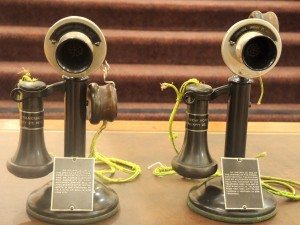

The second is of the four phones used in the call — the one on the far right was the one Woodrow Wilson used in Washington and next to it is the one ATT president Theodore Vail used in Jekyll Island, GA. The line up of phones is Watson, Bell, Vail and Wilson.
The next image is of Bell making the call from NYC and the last is Watson receiving the call in San Francisco.
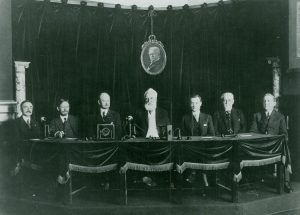
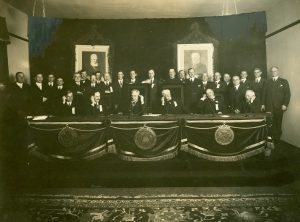
“The first transcontinental phone call was not only a breakthrough for AT&T, it was a key milestone in
our nation’s rich history of innovation,” said Ken McNeely, President of AT&T California. “A hundred years ago, the world marveled as AT&T was able to send the human voice over 3,400 miles of wire from one coast to the other. Today, we can hold the whole of human knowledge in the palm of our hand.”
Mr. McNeely should probably have also mentioned we can now call anywhere in the world using our smart phones, something that Bell and Watson probably never even dreamed of.
As I stood looking at these phones in front of me, I found myself in a state of awe. Here were the actual devices Alexander Graham Bell and Thomas Watson held to make this historic call.
I suppose this might sound childish but to me they were almost sacred. I tried to imagine what it would be like standing in that crowd in San Francisco witnessing this in person. I tried to think about the surroundings of the Palace of Fine Arts where this first call was made and where this Exposition/World’s Fair took place.
And how, during the year of the Pan-Pacific Exposition and World’s Fair, these phones were used to demo the concept of long distant communication by letting people listen to the water splashing against the shores of Rockaway Beach in N.Y. How they must have marveled to the sound of music or the reading of news being sent live from New York to SF over this long distance line. Imagine the wonder in these folks as they were witnessing a new era of communication.
It is amazing to me how much technology has advanced in just 100 years. Imagine what else technology may bring to us in the next 100 years.
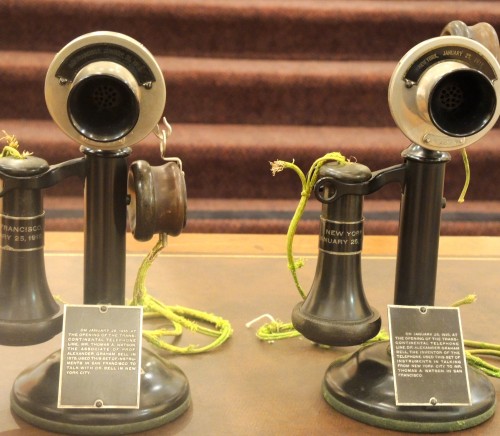
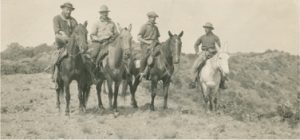


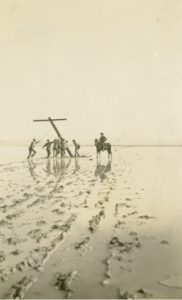

One additional thought is that the technology developed for the early long-distance phone system ended up playing an vital role in computers. For example, the relay developed for long-range phone circuits ended up critical in early computers. AT&T should get a lot more credit than it does because antitrust agreements kept it out of the direct computer business for decades when it was taking critical steps from Claude Shannon’s development of mathematical communications theorem to Dennis Ritchie’s creation of C.
Assuming that AT&T was responsible for the century celebration, it was a bit of a shame. The AT&T made history fell apart in the 1990s, loaded by the affects of poor decisions to settle the last antitrust case and terrible management. SBC acquired the name and little of anything else.
How true…ATT was very different back then.
Long distance phone service required low-distortion amplifiers, too. Early vacuum tube amps daisy-chained together to push signals through miles of copper made a mess of things, and so another HUGE innovation was the use of negative feedback in electronics – it reduced signal distortion by orders of magnitude, enabling long distance calls to be intelligible. Feedback was poorly understood in the early days, but now lies at the very heart of systems control.
There’s an astonishing set of five volumes called A History of Engineering and Science in the Bell System. Unfortunately out of print, but can be hunted down. Also the full record of the Bell Telephone Lab Journal is online at the Alcatel-Lucent web site, http://www.alcatel-lucent.com/bell-labs-journals.
It’s dry stuff but fascinating.
$483.99 to $zero in less than 100 years.
The only thing preventing free worldwide calls are the state-owned telecoms.
In my lifetime, I have personally gone from a home phone with no dial (you asked the operator to connect you) to an iPhone.
Totally amazing to me.
Great Friday morning read. Thanks!
Wow, great blog article.Much thanks again. Will read on…
Great information shared.. really enjoyed reading this post thank you author for sharing this post .. appreciated
Thank you for great article. I look forward to the continuation.
May I request that you elaborate on that? Your posts have been extremely helpful to me. Thank you!
I was curious if you ever considered changing the layout of your website? Its very well written; I love what youve got to say. But maybe you could a little more in the way of content so people could connect with it better. Youve got an awful lot of text for only having 1 or two pictures. Maybe you could space it out better?
You’ve the most impressive websites.
Hi, I do believe this is an excellent site. I stumbledupon it 😉 I’m going to revisit yet again since
i have book-marked it. Money and freedom is the best way to change,
may you be rich and continue to guide other people.
I’ve been browsing online greater than 3 hours as of
late, but I by no means discovered any interesting article like
yours. It is lovely value sufficient for me. In my view,
if all website owners and bloggers made excellent content material
as you did, the net will likely be a lot more helpful than ever before.
very good publish, i definitely love this web site, keep on it
In line with my research, after a property foreclosure home is bought at a bidding, it is common for any borrower in order to still have a remaining unpaid debt on the mortgage. There are many financial institutions who attempt to have all rates and liens cleared by the future buyer. Having said that, depending on certain programs, legislation, and state laws and regulations there may be many loans which are not easily fixed through the transfer of personal loans. Therefore, the obligation still remains on the client that has obtained his or her property in foreclosure. Thank you for sharing your ideas on this site.
The crux of your writing while appearing agreeable in the beginning, did not settle very well with me after some time. Somewhere within the sentences you actually managed to make me a believer unfortunately only for a very short while. I nevertheless have a problem with your jumps in assumptions and one would do well to fill in those gaps. In the event that you actually can accomplish that, I could undoubtedly be impressed.
You made some decent factors there. I looked on the internet for the problem and found most individuals will go along with with your website.
Thanks for this glorious article. Yet another thing to mention is that nearly all digital cameras can come equipped with a zoom lens that allows more or less of that scene for being included by means of ‘zooming’ in and out. Most of these changes in target length are generally reflected while in the viewfinder and on significant display screen right at the back of the actual camera.
One thing I’d like to say is that often car insurance canceling is a horrible experience so if you’re doing the appropriate things as a driver you’ll not get one. A lot of people do obtain notice that they’ve been officially dumped by their own insurance company they then have to scramble to get added insurance following a cancellation. Low-cost auto insurance rates are often hard to get after a cancellation. Knowing the main reasons for auto insurance termination can help motorists prevent sacrificing one of the most vital privileges out there. Thanks for the strategies shared through your blog.
I in addition to my pals ended up analyzing the great solutions located on the blog and so quickly I had a horrible suspicion I had not thanked the web site owner for them. My young boys appeared to be consequently very interested to see them and have in effect absolutely been having fun with these things. We appreciate you indeed being very kind and also for going for this form of superior subject matter millions of individuals are really wanting to learn about. My personal honest regret for not expressing appreciation to you sooner.
Greetings from Ohio! I’m bored to death at work so I decided to check out your blog on my iphone during lunch break. I really like the information you provide here and can’t wait to take a look when I get home. I’m surprised at how fast your blog loaded on my phone .. I’m not even using WIFI, just 3G .. Anyways, superb site!
You actually make it appear so easy along with your presentation however I in finding this matter to be really one thing which I feel I would never understand. It seems too complicated and extremely huge for me. I am looking forward to your subsequent submit, I will attempt to get the dangle of it!
I’m not sure exactly why but this weblog is loading very slow for me. Is anyone else having this problem or is it a issue on my end? I’ll check back later on and see if the problem still exists.
Great ?I should definitely pronounce, impressed with your web site. I had no trouble navigating through all tabs as well as related info ended up being truly easy to do to access. I recently found what I hoped for before you know it at all. Quite unusual. Is likely to appreciate it for those who add forums or something, site theme . a tones way for your client to communicate. Nice task..
I do love the way you have presented this specific difficulty and it really does give me some fodder for consideration. However, from everything that I have seen, I basically hope when the feedback stack on that individuals remain on point and don’t embark upon a tirade regarding the news du jour. Anyway, thank you for this outstanding point and although I can not concur with the idea in totality, I value the perspective.
My brother suggested I might like this web site. He was entirely right. This post actually made my day. You cann’t imagine just how much time I had spent for this information! Thanks!